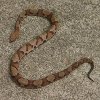Far and away the majority of venomous snakebites reported each year in the US are the work of the Copperhead. If you live within the range in which they are common (like Tennessee) , it will also be common knowledge that you set boundaries and eliminate the few that try to inhabit human high traffic areas, especially traffic by children. Does that mean these are the most common types of encounters? I don't think so. I think it (the high incidence) is the result of their excellent "forest floor" camouflage and their unfortunate defense tactic of first trying to freeze and blend in. That's right, rather than any small hint of agressiveness, the Copperhead plays possum. Or more accurately they use the same freeze and blend in defense that rabbits often adopt. Unfortuantely that means with their astounding camo, they get stepped upon or near enough to trigger a last ditch defensive strike. So I think more often we are in their backyards than they are in ours.
I have seen numerous photos of Copperheads (especialy in hardwood fall forests) in "plain sight" that you had to play where's waldo to even find when looking for them.
Luckily the venom is not particularly destructive in the pantheon of pit vipers. A healthy adult in prime age would be expected to survive an "average" bite, perhaps with some disfigurement. Children and the infirm are in more jeapordy. Their range covers a lot of ground where immediate medical intervention is quite difficult, and supply of antivenin is more dicey and inconsistent than most realize.
In North America, as far as pit vipers go (excluding Corals as they are not pit vipers, but closer to a Cobra in family), the Mojave Rattler has the most potent venom (the green fellow pictured earlier in the thread) and the Western Diamondback is the fellow likely to deliver the most quantity, but based on the likelyhood of being bitten or the frequency of same the Copperhead is the continent's "most dangerous snake".
I believe Tenessee law may be intended to prevent the Texas style "rattlesnake roundup" type killing, but I am no lawyer so I will stick with, regardless of law, Hillbillies kill them when deemed necessary, and probably practice shut up and dig if worried about enforcement. Even if not a lawyer I am a Hillbilly by extraction at least and think pretty confidently that what I have said is correct.
P.S. The bit about them smelling like cucumbers is BS as far as my experience goes, if you want to get one and perform smell tests maybe you can substantiate or dispose of this as a myth. As far as I can tell you from numerous sightings over many years, never smelled a cucumber and it is no prevention tactic.





